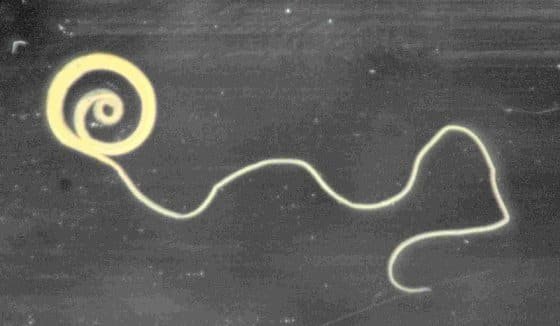A whipworms infection is not considered a serious problem in cats. That’s because it is not as common in felines as it is in dogs.
Besides, whipworm infection is the least prevalent among the four common intestinal parasites in cats, along with hookworms.
In fact, a study on the frequency of intestinal parasites in cats and dogs in France recorded no whipworms and hookworms in cats. Instead, the study recorded an 11.3% and 3% prevalence for roundworms and tapeworms, respectively. This prevalence was higher than what was recorded in dogs.
Despite the low prevalence of cat whipworms, a positive diagnosis in cats should be taken seriously and treated promptly. This article will tell you how cats get whipworms and how they are treated. You’ll also read details on keeping your feline friend free of the parasite.
What are Cat Whipworms?

Whipworms are intestinal parasites that take the form of a whip. They have a thick posterior that looks like a whip handle and a thready end that bears the shape of a whip. Whipworms grow to approximately 1.8-3 inches (45-75mm) long. Cat hookworm infection is sometimes termed Trichuriasis in cats.
Not every species of whipworms infects the cat. In North America, Trichuris serrata is the most prevalent cat whipworm, while Trichuris campanula is common among cats in Europe.
Despite these differences in whipworm species, the modes of whipworm infection in cats are similar.
How Do Cats Get Whipworms?
Infected cats and pets pass whipworm eggs in their feces. But whipworm eggs can also be passed to the environment through infected animal flesh. The eggs of whipworms can survive unhatched in the environment for months or even years.
Cats will be infected with whipworms if they ingest the eggs from contaminated water, soil, or food. Once in the cat’s small intestines, whipworm eggs will hatch into larvae within 3 months and move into the large intestines.
Whipworm larvae in a cat’s large intestines burrow themselves in the colon’s mucosa. They feed on nutrients from the cat’s digested food and develop into mature whipworms.
The presence of whipworms in a cat can easily compromise the pet’s immune system. In addition, the cat’s bowels become inflamed. Your cat will then begin to show signs and symptoms of whipworm infection.
Signs and Symptoms of Whipworm Infection in Cats
Like other intestinal parasites, cats with whipworms may not present vivid symptoms in the early stages of infection. Once the whipworm burden in your cat grows, the following symptoms will be noticed:
- Diarrhea.
- Inflammatory bowel disease (IBD).
- Loss of weight.
- Blood in the stool (hemorrhage in the colon).
- Dehydration.
- Anemia (in severe cases).
Your cat may also show a general state of illness by the time whipworms diagnosis is given and before treatment is started.
How is Whipworm in Cats Diagnosed?

At the vets, fecal floatation is used to detect the presence of whipworm eggs in cat feces. The veterinarian will need to differentiate whipworm eggs from those of other intestinal worms.
The use of coproantigen tests is also possible and provides a more precise diagnosis. A study in Southern Florida found that the coproantigen ELISA test detected more whipworm infection in cats than fecal floatation.
Treatment for Whipworms in Cats
There’s really no specialized medication for cat whipworms. Usually, broad-spectrum dewormers are prescribed. These include Febantel/Praziquantel/Pyrantel Pamoate, Mebendazole, and Fenbendazole.
Year-round heartworm prevention meds for cats are considered viable whipworm prevention and treatment options.
Together with dewormers, cats with whipworm complications will be treated for dehydration, anemia, and inflammatory bowel disease.
Can Whipworms in Cats be Prevented?
The primary way of preventing whipworms in cats is maintaining proper hygiene. That’s because cats get whipworms by interacting with infected food, water, soil, and contaminated animal flesh.
As such, you should promptly remove any pet feces around your home and clean your cat’s litter box daily.
Also, keep your cat indoors as much as possible. Roaming cats have higher chances of interacting with whipworm-infected material.
Additional Info on Whipworms
Although humans can get human whipworms (Trichuris trichiura), the cat whipworm does not have a zoonoses risk. That means your cat will not pass whipworms to you.
Featured Image Credit: Alan R Walker, CC BY-SA 3.0, via Wikimedia Commons
